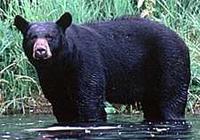Bear, Black
BEAR, BLACK (Ursus americanus spp), inhabits virtually all of BC and is thought to number between 120,000 and 160,000, a quarter of all black bears in Canada. Six subspecies range through the distinct colour morphs of black, brown, cinnamon, creamy white (see BEAR, KERMODE) and blue-grey (the "glacier bear" found in Tatshenshini-Alsek Provincial Park). This genetic diversity likely reflects the diverse habitats and environmental conditions in the province. Bears have heavy bodies, small eyes, short tails and flat feet with short, curved claws for climbing trees. Forests are their natural habitat and they can move through the bush at amazing speeds. Their size varies depending on quality and abundance of food: adult males weigh 60–300 kg while females generally weigh 40–100 kg. The largest black bears are on VANCOUVER ISLAND and the QUEEN CHARLOTTE ISLANDS. Unlike grizzly bears (see BEAR, GRIZZLY), the black bear has no shoulder hump and its muzzle is straight and tapered, where a grizzly's face is flatter and rounder.
Black bears are omnivorous, eating different foods according to the season, although SALMON is a critically important pre-winter food for bears inhabiting watersheds that contain salmon. While they consume mainly vegetation, roots, BERRIES, INSECTS, fish and carrion, they will prey on small mammals and newborn DEER, ELK, MOOSE and CARIBOU. Black bears learn to take advantage of feeding opportunities in their environment, including garbage, orchards, backyard barbecues and campgrounds, so urban development places them in increasing conflict with people. Attacks on humans are infrequent, but black bears can be dangerous and should be treated cautiously.
The female becomes sexually mature at 3–4 years and gives birth to 1–4 cubs every second year depending on the abundance of food. Birthing takes place during hibernation from late autumn to Apr. While populations are stable overall, black bears are vulnerable to poaching, sloppy waste management and agricultural practices, human intolerance and increasing alienation of their habitats. Hunting of black bears is regulated by the Wildlife Branch and reflects their numbers and distribution. The number killed annually in the allowable hunt, however, does not compare with the hundreds killed by conservation officers responding to public complaints and by poachers to supply an illicit international trade in body parts.
by Maggie Paquet

